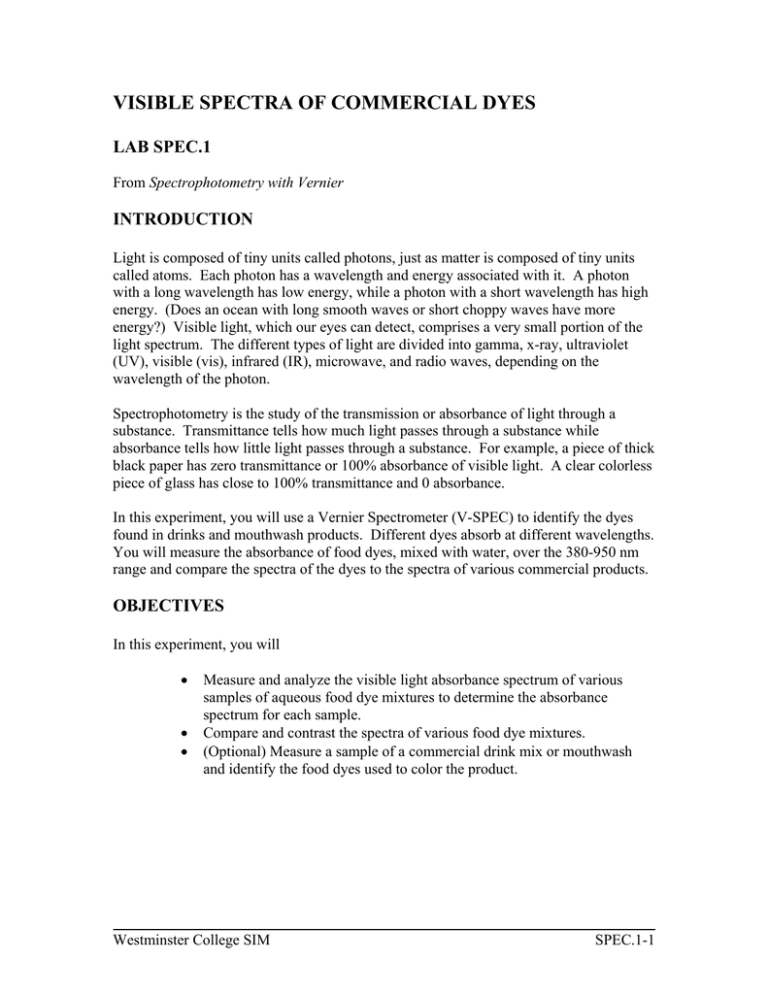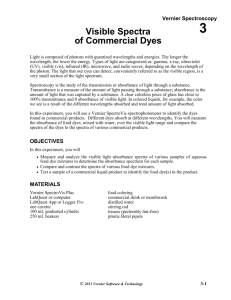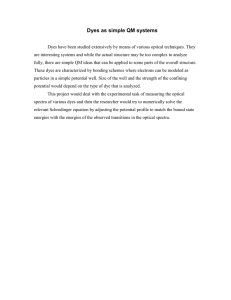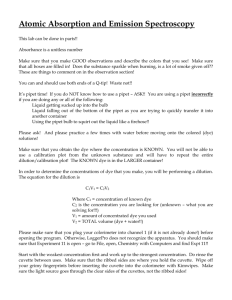VISIBLE SPECTRA OF COMMERCIAL DYES LAB SPEC.1 INTRODUCTION
advertisement

VISIBLE SPECTRA OF COMMERCIAL DYES LAB SPEC.1 From Spectrophotometry with Vernier INTRODUCTION Light is composed of tiny units called photons, just as matter is composed of tiny units called atoms. Each photon has a wavelength and energy associated with it. A photon with a long wavelength has low energy, while a photon with a short wavelength has high energy. (Does an ocean with long smooth waves or short choppy waves have more energy?) Visible light, which our eyes can detect, comprises a very small portion of the light spectrum. The different types of light are divided into gamma, x-ray, ultraviolet (UV), visible (vis), infrared (IR), microwave, and radio waves, depending on the wavelength of the photon. Spectrophotometry is the study of the transmission or absorbance of light through a substance. Transmittance tells how much light passes through a substance while absorbance tells how little light passes through a substance. For example, a piece of thick black paper has zero transmittance or 100% absorbance of visible light. A clear colorless piece of glass has close to 100% transmittance and 0 absorbance. In this experiment, you will use a Vernier Spectrometer (V-SPEC) to identify the dyes found in drinks and mouthwash products. Different dyes absorb at different wavelengths. You will measure the absorbance of food dyes, mixed with water, over the 380-950 nm range and compare the spectra of the dyes to the spectra of various commercial products. OBJECTIVES In this experiment, you will • • • Measure and analyze the visible light absorbance spectrum of various samples of aqueous food dye mixtures to determine the absorbance spectrum for each sample. Compare and contrast the spectra of various food dye mixtures. (Optional) Measure a sample of a commercial drink mix or mouthwash and identify the food dyes used to color the product. Westminster College SIM SPEC.1-1 Visible Spectra of Commercial Dyes MATERIALS Vernier Spectrometer computer pipet pump or pipet bulb one cuvette 10 mL graduated cylinder 250 mL beaker food dyes commercial drink mix or mouthwash distilled water plastic Beral pipet stirring rod tissues (preferably lint-free) PROCEDURE 1. Obtain and wear goggles. 2. Use a USB cable to connect a Vernier Spectrometer to your computer. 3. Start the Logger Pro 3.4.5 program on your computer. 4. Obtain small volumes of various food dyes and record the types (as in Red #40). 5. To set up the Vernier Spectrometer, open the Experiment menu and select Connect Interface →Scan for Spectrometers. 6. Calibrate the Spectrometer. a. Prepare a blank by filling an empty cuvette ¾ full with distilled water. b. Open the Experiment menu and select Calibrate →Spectrometer. The following message appears in the Calibrate dialog box: “Waiting….seconds for the device to warm up.” After 60 seconds, the message changes to: “Warmup complete.” c. Place the blank in the cuvette holder of the Spectrometer. Align the cuvette so that the clear sides are facing the light source of the Spectrometer. Click “Blank Cuvette Ready”, and then click . 7. Conduct a full spectrum analysis of a food dye samples. a. Empty the blank cuvette and rinse it twice with small amounts of a food dye mixture. Fill the cuvette ¾ full with a food dye mixture and place it in the Spectrometer. Align the cuvette so that the clear sides are facing the light source of the Spectrometer. b. Click Collect . A full spectrum analysis of the food dye sample will be graphed. c. Examine the graph, noting the peak or peaks of very high absorbance or other distinguishing features. Save and/or print a copy of the graph. 8. Repeat Step 7 with the remaining food dye samples. Remember to keep a copy of each graph. Westminster College SIM SPEC.1-2 Visible Spectra of Commercial Dyes 9. Obtain a sample of a commercial product containing a dye, such as mouthwash or beverage. Repeat Step 7 with the commercial product. 10. Close down the Spectrometer and Logger Pro 3.4.5. a. Open the File menu and select Exit. b. Open the Experiment menu and select Remove Interface →Spectrometer. DATA TABLE Trial Food Dye (or product ) Peaks or unique features of spectrum 1 2 3 4 DATA ANALYSIS 1. Describe, in detail, the spectrum of each food dye sample. Emphasize the features of each spectrum that distinguish it from the others. 2. Identify the wavelengths and absorbance values of every peak in the graph of each food dye. 3. Identify the food dye or dyes present in the commercial product that you tested. Support your identification with specific information from your testing. Westminster College SIM SPEC.1-3





